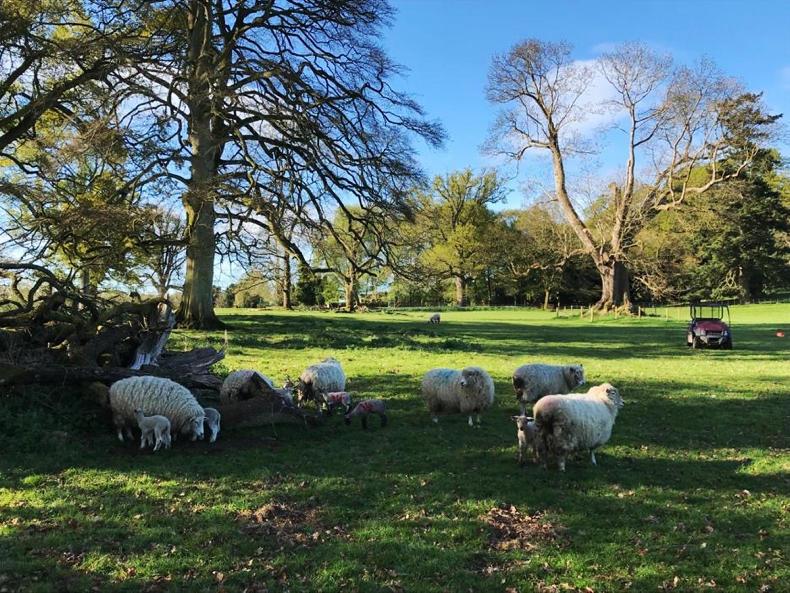Our sheep are managed as two separate flocks. The first flock extends to 400 ewes that lamb indoors during February and March.
The second flock consists of 130 Romney ewes lambing down in April. In the past, these ewes would have lambed indoors.
However, this year we made the decision to lamb the Romney ewes outdoors. To-date, it has proven to be a good move.
Granted, the weather conditions have been a dream for lambing outside. But we have seen other benefits coming through.
Fewer problems
In previous years, when the Romney ewes lambed indoors, we found it hard to keep them from going overfat, even on a forage-only diet. This usually led to multiple problems with prolapse.
However, after outwintering on grass, ewes were much leaner and fitter in the runup to lambing and the usual prolapse problems have ceased.
Less assistance
Ewes are lambing more or less on their own. Mortality is running much lower than previous years and as of the weekend, we have lost just seven lambs from 69 ewes lambed.
In fairness, we did lose a couple of ewes in the field that possibly could have been saved if we had managed to intervene earlier.
Feed costs
As well as cutting down on lambing problems, we have seen a huge saving in winter feed costs. By our estimation, we have used a quarter of the concentrate feed we would have used in previous years by lambing outdoors.
Ewes were on a grass-only diet up to three weeks prior to lambing, at which point we introduced a 19% protein ration, which cost £254/t (€288).
To cover trace elements, all ewes were given a mineral bolus and we feel this has been a great success
Normally, these ewes would have been housed one month ahead of lambing and offered haylage plus concentrates.
To cover trace elements, all ewes were given a mineral bolus and we feel this has been a great success.
Ewes are lambing with ease, lambs are livelier at birth and are much quicker to stand and suck.
Lamb numbers
The Romney ewes were scanned on 10 February. From scanning records, we had 86 twins, seven sets of triplets and 37 singles.
Triplet lambs are caught and cross-fostered to single-bearing ewes as required
As of last weekend, we still have 61 ewes left to lamb. Ewes were served by Suffolk and Ile de France rams. The Ile de France ram is a new introduction to the flock and was chosen as a trial.
Lamb numbers are recorded in the field, as well as tail docking. Triplet lambs are caught and cross-fostered to single-bearing ewes as required.
Tweaking the system
With limited housing space, we will look at lambing outdoors again next year. While the weather may well be different, there are a few things we will plan ahead for.
As all ewes were wintered on-farm, we were tight for grass for three to four weeks during late March and early April.
Having more grass for ewes post-lambing means we could cut out meal feeding
So, to build up a bank of grass for the lambing period, as well as post-lambing, we will look into sending ewes away to winter grazing for a period.
Having more grass for ewes post-lambing means we could cut out meal feeding. At present, we are supplementing ewes with 0.5kg/day of the 19% nut. But grass is starting to come, so meal feeding will stop shortly.
Crossbred ewes settled at grass
Our main flock consists of 400 breeding ewes which are a mix of Suffolk, Suffolk x Cheviot and Dorset breeding.
These ewes ran with Suffolk and Dorset rams, with scanning results lower than we would have liked at 170%.
Housing is a combination of straw bedding and wire mesh flooring
All ewes were housed in early January and offered haylage indoors. Housing is a combination of straw bedding and wire mesh flooring.
Concentrate feeding started around three weeks prior to lambing, with all ewes getting a 19% nut.
Delayed turnout
Unfortunately, the weather was less favourable in February and March, so the earliest-lambing ewes were held indoors for at least 10 days before they went out to grass.
As a consequence, we have had a few issues with joint ill in some lambs, which have now been addressed.
Simplifying management
To keep flock management simple, we batch up the ewes for grazing based on the week they lambed down.
For example, all ewes lambing in the first week are grouped together and go to grass as one lot, and so on.
Due to the way the sheep are grouped, we bring in one group per week and treat all lambs in each batch
We have four groups at grass. The benefit of this is that when carrying out routine management tasks at grass, lambs are much more even in age and size.
We give lambs a clostridial vaccine once they reach six weeks of age.
Due to the way the sheep are grouped, we bring in one group per week and treat all lambs in each batch. As of this week, three of the four groups have been vaccinated.
Reseeding
We are finishing off some draining work on 60ac of grassland before reseeding this week. In the past two years, there have been 100ac of grass reseeded on-farm.
Fertiliser has now been spread across the grazing ground and we opted for a product with added selenium.
The Dexter cattle are destined for the restaurant trade
Demand for grass is high, as the farm also carries 30 spring-calving cows, of which 24 have calved, along with 56 Dexter calves. The Dexter cattle are destined for the restaurant trade, as well as some home sales.
Silage ground has been closed up after being grazed. Regrowth has been slow, but hopefully we will manage to get silage harvested in early June.






 This is a subscriber-only article
This is a subscriber-only article









SHARING OPTIONS: